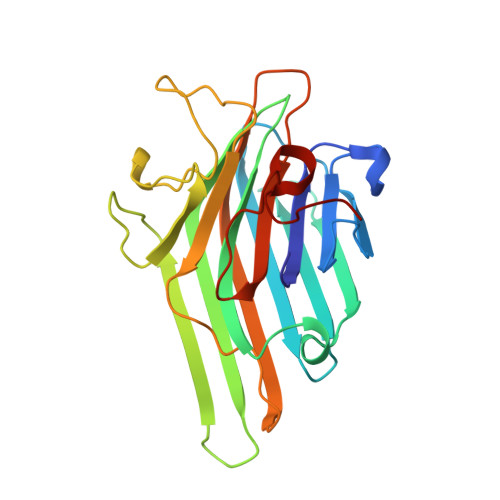The crystal structure of the complexes of concanavalin A with 4'-nitrophenyl-alpha-D-mannopyranoside and 4'-nitrophenyl-alpha-D-glucopyranoside.
Kanellopoulos, P.N., Pavlou, K., Perrakis, A., Agianian, B., Vorgias, C.E., Mavrommatis, C., Soufi, M., Tucker, P.A., Hamodrakas, S.J.(1996) J Struct Biol 116: 345-355
- PubMed: 8812993
- DOI: https://doi.org/10.1006/jsbi.1996.0052
- Primary Citation of Related Structures:
1VAL, 1VAM - PubMed Abstract:
Concanavalin A (Con A) is the best-known plant lectin and has important in vitro biological activities arising from its specific saccharide-binding ability. Its exact biological role still remains unknown. The complexes of Con A with 4'-nitrophenyl-alpha-D-mannopyranoside (alpha-PNM) and 4'-nitrophenyl-alpha-D-glucopyranoside (alpha-PNG) have been crystallized in space group P2(1)2(1)2 with cell dimensions a = 135.19 A, b = 155.38 A, c = 71.25 A and a = 134.66 A, b = 155.67 A, and c = 71.42 A, respectively. X-ray diffraction intensities to 2.75 A for the alpha-PNM and to 3.0 A resolution for the alpha-PNG complex have been collected. The structures of the complexes were solved by molecular replacement and refined by simulated annealing methods to crystallographic R-factor values of 0.185/0.186 and free-R-factor values of 0.260/0.274, respectively. In both structures, the asymmetric unit contains four molecules arranged as a tetramer, with approximate 222 symmetry. A saccharide molecule is bound in the sugar-binding site near the surface of each monomer. The nonsugar (aglycon) portion of the compounds used helps to identify the exact orientation of the saccharide in the sugar-binding pocket and is involved in major interactions between tetramers. The hydrogen bonding network in the region of the binding site has been analyzed, and only minor differences with the previously reported Con A-methyl-alpha-D-mannopyranoside complex structure have been observed. Structural differences that may contribute to the slight preference of the lectin for mannosides over glucosides are discussed. Calculations indicate a negative electrostatic surface potential for the saccharide binding site of Con A, which may be important for its biological activity. It is also shown in detail how a particular class of hydrophobic ligands interact with one of the three so-called characteristic hydrophobic sites of the lectins.
Organizational Affiliation:
Europeam Molecular Biology Laboratory, Heidelberg, Germany.

















